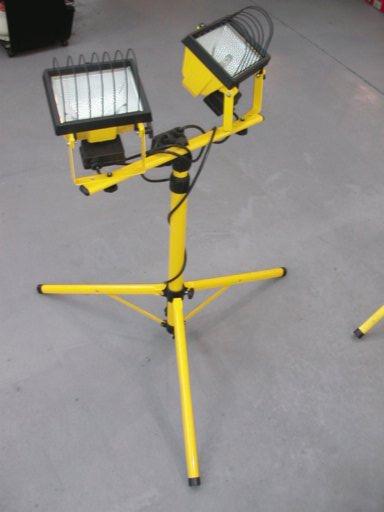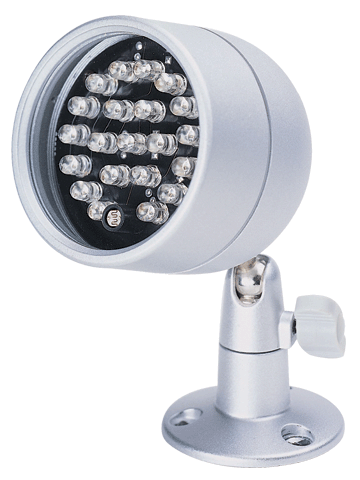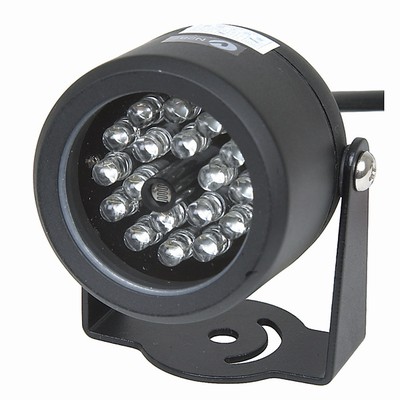Wow, it has been a long time since I last posted! Well, what has been a very busy uni year is over now, so I will try my very best to post a bit more frequently, at least until the next academic year starts!! To kick off I thought I would describe how to put together an infra red light source. I had a surprisingly difficult time finding what I needed to know to do this so I thought I would post what I found out in case it helps anyone else. To prevent the post getting too long I have split it into two parts, the first just describing what I ended up deciding to do to in order to get hold of an infrared light source and in the next post I will describe how to actually put the thing together.
During the year I needed to film some of my experiments in complete darkness and so looked into getting some infrared lights. There are a lot of web cams on the market that use infrared these days so I thought it would be easy. It turns out that there are two ways of producing infra red light. One is to use a light source that produces light in the infra red part of the spectrum such as that produced by infra red LEDs, the alternative is to use a white light source and fit it with a filter to cut out all wavelengths except for infrared.
The latter could be done by buying long pass filter glass such as RG850 by Schott (eg www.galvoptics.fsnet.co.uk/rg850.htm) and having it cut to fit halogen floodlights from Bunnings (see picture below).

The floodlight only costs about $26.00 from Bunnings, but for one 165mm x 165mm sheet of RG850 filter glass, 3-4mm thick, cut into three 76x41mm pieces that would replace the glass in the floodlights, it would cost $779.90. Why it needed to be so expensive is beyond me, but that is science for you.
Looking into infrared emitting lights didn’t seem that much better. An exhaustive search didn’t turn up that many options. The best were also quite expensive, though not as bad as the Schott filter glass. A light capable of illuminating to ~30 metres was $US150, which wasn’t too bad.
My lab funding didn’t extend quite that far so I was looking at cheaper options and settled upon Infrared LED light sources. There are security lights made with LED’s (eg www.wirelesshouse.com.au/p1623/s932/IR_Lamp_PRH_5218) but those were still around $150.00.

Jay car had a smaller version (www.jaycar.com.au) which was only $49.95 but I thought only 18 LEDs would be a bit dim.

In the end I decided that it would probably be easier if I just made it my self. I found the ideal kit at Oatley Electronics (oatleyelectronics.com) which was only $29.00 and let you build a 140 LED light source. I decided to make 2 so I bought two of those.
The kit came with only 35 LEDs that emitted light at 880nm. I had tested the camera I was going to use (a JVC Everio GZ-MG30 hard drive camera) and 850nm seemed to be picked up better by the CCD chip, so I also bought 280 x 850nm LEDs from Futurlec (www.futurlec.com) which cost $65.00 ($56.00 for the LEDs, $9.00 postage)
So that is how I came to be building my own infrared light source. Part two of this post will be instructions on how to assemble the kit. This is both to explain to those interested how it is done, but also because as a result of some confused marketing decision there were no instructions with the kit itself…
The second part of this post can be read here.

8 responses so far ↓
1 Anthony // May 17, 2009 at 5:15 am
I like what you’re doing here. Looks like a fun project. I’m just curious as to where you obtained that many IR LEDs?
2 FastLife // May 18, 2009 at 9:19 am
Hi, I got the LED’s from an online electronic components store called Futurlec (www.futurlec.com).
3 Graham // Aug 24, 2009 at 7:30 pm
Looks like fun, i’d like to do the same but time
is something i don’t have….what was the illuminating distace? looks like you could do a distance of 10 ~ 15 mtrs.
4 FastLife // Sep 23, 2009 at 11:40 am
I’m not sure Graham. The lights easily lit up a 4m x 3m room like a beacon (albeit an invisible infra red beacon). I am hoping to take my infrared camera out side at some point and set up some markers at increasing distances to see how far the light can illuminate. I would expect easily 10m but we will see.
5 kodama.pixel » Blog Archive » Digital Studio – Week 04 // Mar 30, 2010 at 1:54 pm
[…] environment to track movement clearly. I’ve also discovered an excellent tutorial to create your own infrared LED floodlight, which may end up being a semester 2 project this […]
6 trying to build a home made night vision camera // Mar 12, 2012 at 6:52 pm
[…] kit is already assembled if you want to use it. I also found this link which may help you further http://www.haydnallbutt.com.au/2008/…source-part-1/ what sort of camera you using? From memory if you use a cmos camera then there is an issue…. […]
7 GlobalTechnologies // Sep 10, 2013 at 12:39 am
We are searching for an InfraRed light which sends sufficient light to such that we can read licence plate of cars at min. 1 km. distance in darkness by a night vision goggle.
Required quantity is 400 pcs. after testing a sample.
Please offer if you can supply.
Regards
Kenan yasa
GlobalTechnologies/Turkey
8 FastLife // Sep 10, 2013 at 1:36 pm
I don’t make lights commercially, I just made this one for some research I was doing. The types of LED lights I was using probably wouldn’t project 1km.
There are very powerful LED lights called CREE LED. They are currently being used in applications like LED flood lights (if you google LED flood lights you will see examples of these). These can be seen at a distance of 1km, but whether enough light travels 1km, then returns 1km back to you so you can see a number plate is a bit doubtful. You would probably do better by having bright infra red lights beside the road where the cars will pass so the number plates are illuminated very brightly, then these could probably be read with a strong enough lens on a camera, but you would also need a very good zoom lens. The resolution of your camera and lens is probably going to be more of a problem than being able to illuminate a number plate with infra red light at a distance of at least 1km.
CREE LED lights are available in 940nm infra red which is absoultely invisible to the human eye. eg:
http://www.ebay.com/bhp/cree-led-ir
Lights like this have 12 x 5W CREE LEDs in them:
http://www.dhgate.com/product/2pcs-7-60w-cree-12-led-5w-work-light-driving/161788369.html
If you were ordering 400 of them, you could probably get the company to make them with the infra red 5W LED shown at that link above. I hope this helps.